Physical Address
304 North Cardinal St.
Dorchester Center, MA 02124
Patients with chronic insufficiency of the lateral and posterolateral structures may develop a gait abnormality characterized by excessive knee hyperextension during the stance phase of the gait cycle.
Gait abnormality is easily identifiable in the clinic: increased extension (>0 degrees) in the sagittal plane, associated varus recurvatum.
Patients with knee hyperextension gait problems present with varying amounts of altered gait mechanics, symptoms, and functional limitations.
Degree of the gait abnormality during the stance phase depends on the magnitude of associated ligamentous deficiencies, quadriceps muscle atrophy, and symptomatic patellofemoral arthrosis.
Complaints of either partial or full giving-way during routine daily activities are frequent.
Pain is in medial compartment, posterolateral tissues.
Increased risk of failure of cruciate and posterolateral reconstructions exists if the gait abnormality is not corrected before surgery.
Patients with chronic insufficiency of the lateral and posterolateral structures of the knee may develop a gait abnormality that is characterized by excessive knee hyperextension during the stance phase (initial contact or heel strike, loading response, midstance, and toe off) of the gait cycle ( Fig. 29-1 ). The primary lateral and posterolateral structures of the knee joint are the fibular collateral ligament (FCL) and popliteus muscle-tendon-ligament unit (PMTL), including the popliteofibular ligament (PFL) and posterolateral capsule (PLC). These structures function together to resist lateral tibiofemoral compartment opening, posterior subluxation of the lateral tibial plateau with tibial rotation, knee hyperextension, and varus recurvatum (see Chapter 15 ). Posterolateral injuries are frequently accompanied by a rupture to the anterior cruciate ligament (ACL) and, in some cases, a rupture to the posterior cruciate ligament (PCL). In addition, many knees with insufficiency to the posterolateral structures also have varus osseous malalignment. The comprehensive physical examination and radiographic evaluation required to determine all of the abnormalities that exist in these complex knee joint injuries are detailed in Chapters 16 and 26 .
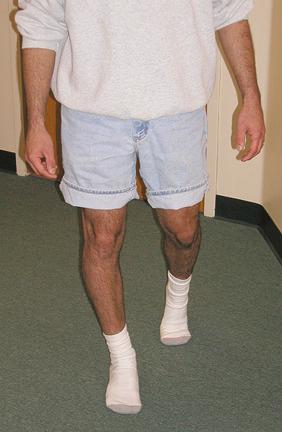
The gait abnormality described in this chapter is easily identifiable in the clinic if the examiner devotes a small amount of time to observation during the initial patient presentation. An abnormal knee hyperextension gait pattern involves increased extension (>0 degrees) in the sagittal plane and, frequently, associated varus malalignment in the coronal plane (varus recurvatum). The varus recurvatum position of the knee will be markedly worse if there is associated osseous tibiofemoral varus malalignment. The triple varus knee , described in detail in Chapter 26 , refers to varus alignment caused by three factors: tibiofemoral varus osseous malalignment, increased lateral tibiofemoral compartment separation because of marked insufficiency of the FCL and PMTL, and varus recurvatum in extension. An abnormal increase in hyperextension usually indicates damage to not only the posterolateral structures but the ACL as well.
Some knees with uninjured but physiologically slack posterolateral structures demonstrate a passive varus recurvatum and excessive knee hyperextension. After a knee injury or muscle atrophy of any cause, the patient may demonstrate a hyperextension gait pattern caused by muscle weakness. Other patients with symptomatic patellofemoral arthritis develop a hyperextension gait pattern to avoid knee flexion that loads the patellofemoral joint and causes anterior knee pain. These patients are the most difficult to manage because the knee arthritis symptoms require treatment to relieve the painful state in addition to correcting quadriceps weakness and the knee hyperextension gait pattern.
In our experience, patients with knee hyperextension gait problems present with varying amounts of altered gait mechanics, symptoms, and functional limitations. Some may demonstrate a markedly abnormal gait that is severely disabling and limits ambulation, requiring crutch or cane support. Others may have a less noticeable alteration, with the abnormal knee hyperextension occurring only after excessive walking (or other weight-bearing activities) and muscle fatigue. The degree of the gait abnormality during the stance phase depends on the magnitude of associated ligamentous deficiencies, quadriceps muscle atrophy, and symptomatic patellofemoral arthritis.
Subjective complaints of knee instability of either partial or full giving-way during routine daily activities often accompany the knee hyperextension gait abnormality. Pain is frequently located in the medial tibiofemoral compartment, which is caused by increased compressive forces owing to the varus malalignment. Pain in the posterolateral tissues also occurs from increased soft tissue tensile forces. In addition to the pain and instability caused by this gait pattern, there is an increased risk of failure of posterolateral reconstructions if the gait abnormality is not corrected before surgery. This is because of the excessively high tensile forces from high knee extension and adduction moments that are expected be resumed during weight-bearing activities after surgery. In addition, patients with associated ACL or PCL deficiency may have an increased risk of failure of cruciate ligament reconstructions if the hyperextension pattern is not corrected before surgery. Therefore, gait retraining and avoidance of the gait hyperextension pattern are paramount for both resolution of patient symptoms and reduction of the risk of failure of soft tissue ligament reconstructive procedures.
Many investigators have described a quadriceps-avoidance abnormal gait pattern in patients with ACL ruptures. An investigation at our center documented diminished quadriceps activity and enhanced hamstring muscle activity in half of 32 ACL-deficient varus-angulated knees. Although the increased hamstring muscle force could be assumed to be beneficial because it provides a protective mechanism in decreasing anterior tibial translation, the increased muscle force creates high axial compressive forces and therefore increases medial and lateral joint compartment (calculated) loads. These loads could be deleterious to the joint over the long term, especially in knees with associated varus osseous malalignment. The abnormal gait characteristics of the ACL-deficient knee are discussed in detail in Chapter 6 .
A hyperextension gait abnormality pattern is also found in patients who have had a stroke or traumatic brain injury, cerebral palsy, or poliomyelitis. In these instances, the disorder may occur owing to many factors, including quadriceps weakness, ankle plantar flexion spasticity, heel cord contracture, and gastrocnemius-soleus weakness. The concern is that the abnormal knee hyperextension may cause stretching of the posterior ligamentous and capsular structures from the increased external extensor torque that is placed across the knee during stance. It is not the purpose of this chapter to discuss the treatment of this problem in patients with neurologic pathology. Rather, this chapter focuses on the treatment of this gait disorder in patients with chronic insufficiency of the posterolateral structures, with or without cruciate ligament ruptures or varus malalignment.
Loss of normal knee flexion and extension patterns throughout the stance phase is noted in patients with hyperextension gait abnormalities.
Pattern I: Abnormal hyperextension occurs during heel strike and terminal extension, with knee flexion noted during the loading response. Exceedingly high knee extension moments exist, along with an abnormal reversal of hip extension and ankle dorsiflexion.
Pattern II: Prolonged knee hyperextension pattern from heel strike throughout midstance. Knee flexion moment is markedly below normal.
Abnormal tibiofemoral alignment (varus-valgus osseous malalignment or anterior-posterior tibial slope) affects knee-thrusting motions in the sagittal or coronal plane.
Varus thrust gait abnormality is caused by a varus tibiofemoral osseous malalignment. Thrusting motion occurs with the knee near full extension immediately after heel strike.
The normal pattern of knee motion that occurs during the gait cycle is shown in Figure 29-2 . A detailed description of normal human gait mechanics is beyond the scope of this chapter and has been presented by many authors. The loss of the normal knee flexion and extension patterns throughout the stance phase noted in patients with hyperextension gait abnormalities has important functional implications. During the loading response, normal amounts of knee flexion are required for the knee joint to absorb shock. A limb that is instead hyperextended transfers body weight directly from the femur to the tibia, resulting in abnormally high compressive forces. The usual muscle energy absorption and cushioning effect a flexed knee provides are lost. The thrusting hyperextension motion at the knee is associated with an abnormally high adduction moment, which tends to increase medial tibiofemoral compartment compressive forces and lateral distraction forces. The increased compressive forces manifest as pain in the medial tibiofemoral compartment and posterolateral soft tissues.
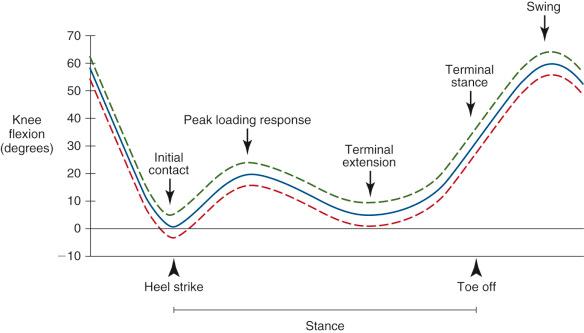
We have reported two distinct knee hyperextension gait patterns. In pattern I , the abnormal hyperextension occurs during two periods of the stance phase, heel strike and terminal extension ( Fig. 29-3 ), with knee flexion noted during the loading response. Exceedingly high knee extension moments are present, along with an abnormal reversal of hip extension and ankle dorsiflexion. Pattern II is characterized by a prolonged knee hyperextension pattern from heel strike throughout midstance ( Fig. 29-4 ). In these patients, the knee flexion moment is markedly below normal, with its effects incurred primarily at the knee with only a slight delay in ankle dorsiflexion.
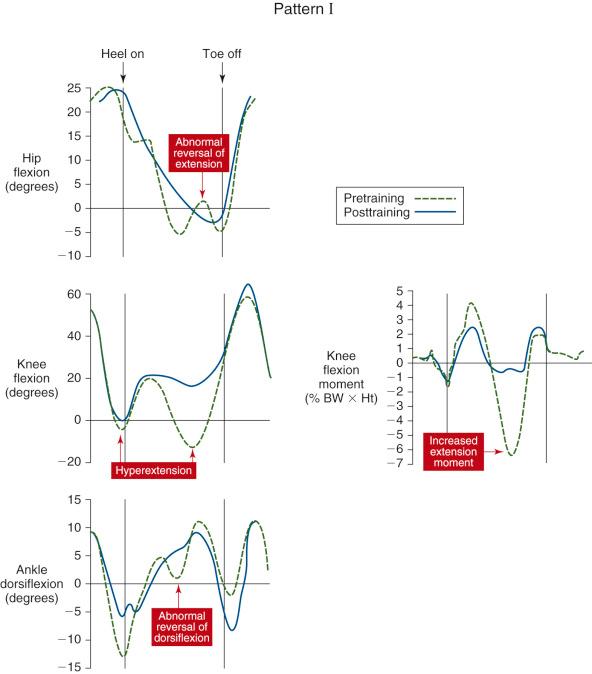
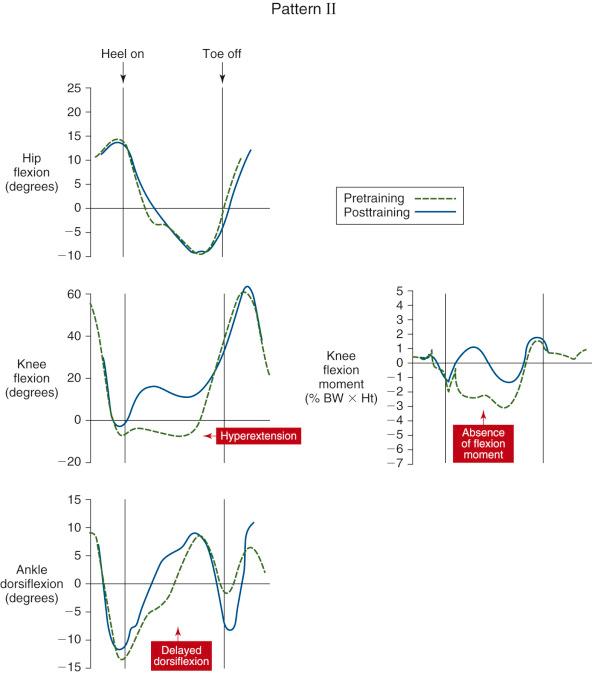
Our clinical observations on the various types of abnormal knee motions and thrusts in the sagittal, coronal, and transverse rotational planes that occur during the stance phase of gait are summarized in Table 29-1 . Any abnormality in tibiofemoral alignment (varus-valgus osseous malalignment or anterior-posterior tibial slope) may affect knee-thrusting motions in the sagittal or coronal plane. The most common of these is a varus-thrusting gait abnormality caused by a varus tibiofemoral osseous malalignment. The thrusting motion occurs with the knee near full extension immediately after heel strike, during the loading response. There may be an associated external or internal rotational subluxation with the varus thrust, depending on the presence of associated deficiency to the posterolateral structures. A less common abnormality, a valgus-thrusting gait, is usually associated with valgus lower limb malalignment. This disorder is typically accompanied by external rotation of the tibia. Knees with these osseous malalignment and associated knee ligament deficiency require surgical correction of the malalignment by osteotomy before ligament reconstructive procedures.
| Stance Phase Event | Abnormal Knee Position | Motion Limit Increased | Phase of Stance | Possible Additional Subluxations | Comments |
|---|---|---|---|---|---|
| Hyperextension motion (thrust) | Hyperextension (pattern I) | Extension | Initial contact, terminal extension phases | Varus-external tibial rotation (recurvatum) | Sudden knee hyperextension-flexion-hyperextension even during stance. Markedly abnormal gait; retraining difficult. |
| Hyperextension motion (thrust) | Hyperextension (pattern II) | Extension | Entire stance phase | Varus-external tibial rotation (recurvatum) | No back-and-forth motion during stance. Gait retraining less difficult. |
| Varus thrust | Tibial adduction (lateral joint opening) | Adduction | Initial contact and loading response phase | Tibiofemoral compartment rotational subluxation * | Usually occurs at loading response. Gait retraining not possible. External tibial rotation may decrease thrusting; internal rotation increases thrusting. Increased external tibial rotation (lateral-posterolateral injury, medial-posteromedial injury, or both). Increased internal tibial rotation is rare, usually ACL plus lateral ligament injury. |
| Valgus thrust | Tibial abduction (medial joint opening) | Abduction | Initial contact and loading response phase | Tibiofemoral compartment rotational subluxation * | Increased external tibial rotation (medial-posteromedial ligament injury), with anterior subluxation of medial plateau. Increased external tibial rotation with lateral-posterolateral injury with posterior subluxation of the medial plateau. |
* Rotational subluxations may also occur in the absence of a varus or valgus thrust.
Program requires two to four sessions with an experienced physical therapist to instruct the patient on the abnormal gait mechanics that occur and the adaptations required to restore a normal gait pattern.
Patient practices at home for at least 2 to 4 hours daily.
Muscle strengthening and neuromuscular coordination training are also performed.
Initial focus is on the knee hyperextension. Patient is instructed to maintain 5 degrees of flexion with every step, walking in a very slow and deliberate manner.
Patient is educated on the abnormal ankle and foot motions that occur concurrently with knee hyperextension. Practices elevating the heel and pushing off with the forefoot and toes in the midstance phase to avoid knee hyperextension.
Hip and body trunk position are analyzed.
Clinician determines whether an abnormal lower limb alignment (varus or valgus thrust) or an external or internal rotational knee subluxation occurs during stance. Functional knee brace and additional gait retraining may be required.
Heel wedge may be used to place the knee in slight flexion.
Unloading brace or a lateral or medial heel wedge is used for significant varus or valgus malalignment.
Exercises done to target specific muscles used during gait: toe raises for gastrocnemius-soleus complex, straight-leg plus raise and wall-sits for quadriceps.
Balance and proprioception: weight shifting, tandem balance, single-leg balance (stable and unstable), rocker board (front to back and side to side), cup walking, resisted gait activity with a heavy elastic band.
Two to three months may be required to complete the training to the point at which a normal gait pattern becomes routine on a subconscious level.
A gait retraining program has been successfully used at our center for knee hyperextension abnormalities since the middle of the 1980s. The program requires two to four initial clinical sessions (held preferable every week) with an experienced physical therapist to instruct the patient on the abnormal gait mechanics that occur and the adaptations required to restore a normal gait pattern ( Table 29-2 ). The patient is instructed to practice at home for at least 2 to 4 hours daily. In addition, the patient undergoes muscle strengthening and neuromuscular coordination training as part of the comprehensive rehabilitation process. To have a successful outcome, the patient must be compliant with the time commitment and constant motivation required of this program. A family member is also taught the same instructions so he or she can observe and assist with the patient's retraining at home. It is also helpful to video the patient's abnormal and corrected gait to aid the education process. The patient may ultimately require 8 to 12 therapy sessions over 6 to 12 weeks to return to a normal asymptomatic gait pattern.
| Anatomic Part | Retraining Program |
|---|---|
| Trunk-upper body |
|
| Hip |
|
| Knee |
|
| Ankle |
|
| Foot |
|
The initial focus of the retraining process is placed on the hyperextension of the knee for the patient to understand that this is the primary abnormality that requires modification ( Fig. 29-5 ). The patient is instructed to maintain 5 degrees of flexion with each step. This requires walking in a very slow and deliberate manner. A visual aid to provide to the patient is the mental image of a woman walking in high heels, which produces 5 to 8 degrees of knee flexion. In addition, a 1- to 2-inch elevated heel may be used to help maintain flexion throughout stance phase. The clinician should be aware that problems may occur during gait retraining when the patient practices the flexed knee stance. Although the flexed knee gait is advantageous in contributing to quadriceps strengthening, it may aggravate preexisting patellofemoral pain, which must be treated promptly.
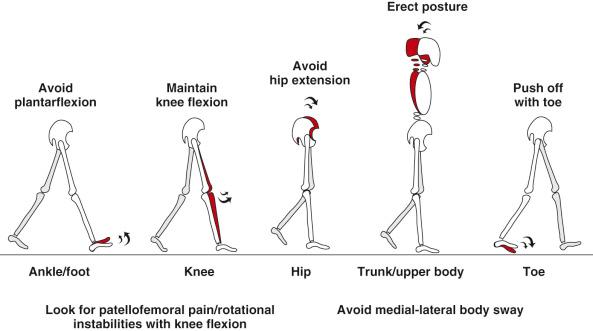
The second step of the training process involves educating the patient on the abnormal ankle and foot motions that occur concurrently with knee hyperextension. The patient practices elevating the heel and pushing off with the forefoot and toes in the midstance phase to avoid knee hyperextension. The patient must limit excessive ankle plantar flexion and assume early ankle dorsiflexion to maintain forward progression of the tibia and flexion of the knee joint. It is helpful to have the patient notice and feel the pressure against the forefoot during the end of stance phase. With the first and second steps, the patient is taught to say “knee-foot” with each stance cycle as a reminder of the normal gait pattern.
When the patient is not practicing the knee-foot adaptation, he or she will revert to the abnormal knee hyperextension pattern. However, within 4 to 6 weeks, it is surprising to note that the gait pattern often returns to normal, and the patient is no longer required to perform a conscious reminder of the gait adaptation. In short, the gait pattern becomes routine.
The third step analyzes the hip and body trunk position (see Table 29-2 ). The fourth and final step of the retraining program determines whether an abnormal lower limb alignment (varus or valgus thrust) or an external or internal rotational knee subluxation occurs during stance. This is important because a primary cause of a patient's abnormal knee hyperextension may be instability of the knee with flexion, so that coronal plane or rotational transverse plane subluxations occur. In these patients, a functional knee brace and additional gait retraining may be required.
In some cases, a heel wedge may be used to place the knee in slight flexion to minimize the midstance hyperextension that can occur with poor quadriceps control. A significant varus or valgus malalignment may require use of an unloading brace or a lateral or medial heel wedge.
There are primarily two different types of unloading braces: single-hinged and bilateral-hinged. Single-hinged braces are able to create a pulling mechanism through the affected compartment, thereby creating the unloading (e.g., when the brace has a medial hinge, the medial compartment is unloaded). With a double-upright hinged system, the brace will typically have a pushing mechanism of unloading (e.g., when attempting to unload the medial compartment, the lateral hinge mechanism will be adjusted to push through the lateral to the medial joint). In custom unloading braces, a fixed amount of unloading can also be built into the brace. The potential added advantage of double-upright unloading braces is the ability to compensate for cruciate and/ or collateral ligament instability. If a brace or heel wedge is used, the patient is reminded to actively practice the gait retraining techniques and not to solely use the brace/wedge as a passive limit to hyperextension. These devices also assist in decreasing the medial or lateral pain complaints that can accompany either joint instability or arthritis.
Voluntary muscle control is critical to help minimize hyperextension gait mechanisms related to diminished quadriceps function. Normal gait requires adequate push-off from the gastrocnemius-soleus complex, sufficient quadriceps contraction in midstance, hip and knee flexion during swing, and an upright posture. Defects in any of these mechanisms will permit gait alterations, and, when completed with sufficient frequency, become the default gait pattern for the patient. Gait is a learned activity and eventually becomes habitual. Therefore gait retraining should include exercises to target the specific muscles during gait, pregait activities to methodically force the patient to think about using these muscles functionally, and then the act to practice the new gait pattern so it eventually becomes the learned default pattern to avoid the hyperextension gait mechanism.
In some knees with varus malalignment, there is an associated internal tibial torsion and toe-in gait. The patient may voluntarily decrease the varus thrust by purposely walking with a toe-out gait; however, when the patient is not practicing, the toe-in gait resumes. The same situation applies to a valgus knee alignment with a pronated toe-out gait. The gait retraining therefore is primarily to address knee hyperextension in which most patients will achieve a beneficial response to the program.
The following sections represent examples of how exercises may be coupled with other activities to assist with gait retraining. An important component of gait retraining is to target exercises for the specific muscles required during the gait cycle. For the gastrocnemius-soleus complex, the patient is instructed on the toe-raise exercise. This exercise can be progressed to move from using double stance to eccentric/negative repetitions (up with two legs/down with a single leg) and eventually to single-ankle plantar flexion lifting. Other options are to move from the floor to the edge of a step or to add additional weight for increasing the workload. The exercise can also be combined with traditional step-up exercises.
Quadriceps control is critical for normal gait and represents the muscle group that demands the most attention. Common exercises that have been shown to be effective in helping with quadriceps reeducation include the straight leg plus raise ( Fig. 29-6 ), performed with the patient in the seated position. The quadriceps is contracted; the leg is lifted approximately 6 inches off the table or chair, held in the lifted position for 15 seconds, and then lowered and relaxed for 45 seconds. This 1-minute cycle is maintained and progressed in ratios (1 : 3, 1 : 2, and eventually, 1 : 1) and then progressed from 5 to 10 repetitions, with additional ankle weight being added to increase the difficulty of the exercise.
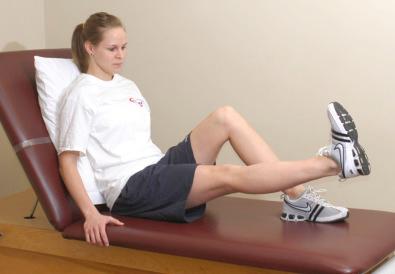
Isometric wall sits are an excellent method of facilitating quadriceps activation. The desired angle of knee flexion is typically between 45 and 70 degrees. Patients with patellofemoral joint arthritis may need to maintain the angle of flexion between 30 and 45 degrees to decrease patellofemoral pain. Patients who do not have joint damage or pain may perform this exercise in deeper degrees of knee flexion to allow for an increase in quadriceps muscle fiber recruitment. Having the patient keep weight pressures through the heels will also decrease the potential for patellar pain complaints. This exercise is similar to a stationary leg press and is performed as two repetitions, four times a day to a maximum fatigue, experiencing a quadriceps burning sensation. The patient tries each exercise and attempts to reach a 3-minute-total duration for each wall sit repetition.
Active isometric hip adduction during the wall sit by compressing a ball between the knees may assist vastus medialis oblique recruitment. In addition to obtaining adequate quadriceps control, it is important to improve hip abduction control. A heavy elastic exercise band may be placed proximal to the knee (avoiding patellar pressure) and clamshells are performed in either the hook-sitting ( Fig. 29-7, A and B ) or the side-lying (see Fig. 29-7, C and D ) position. Three to five sets of 10 repetitions are performed. Adjustments to either knee flexion or hip flexion angles can make the exercise easier or more difficult depending on what is necessary to challenge the gluteal musculature. The single-leg squat test ( Fig. 29-8 ) may be performed to detect poor hip strength and trunk control, discussed in detail in Chapter 13 .
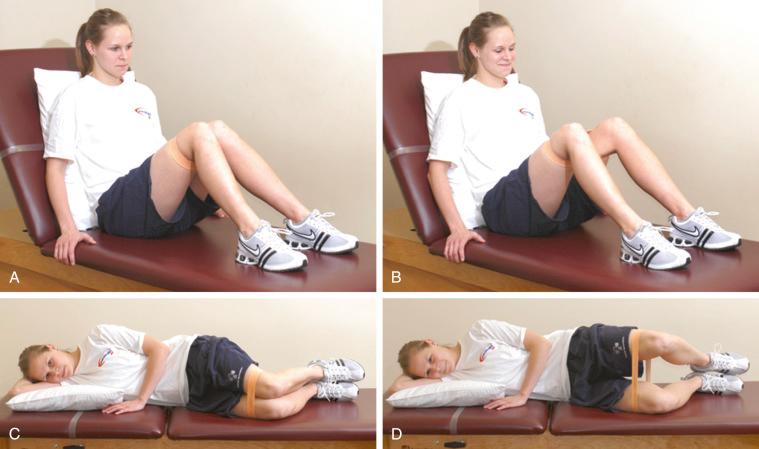
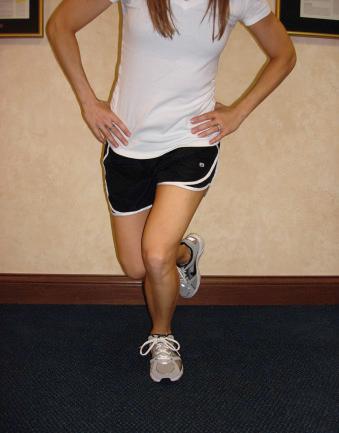
Normal hip abductor and external rotation strength and control of the lower limb are required to prevent the internal hip rotation-valgus lower limb position that is often observed in patients with chronic patellofemoral symptoms.
Balance and proprioception are important components of a gait-retraining program. The patient must be able to maintain single-stance control, as well as move the opposite leg through swing and be ready for the transition into the next stride. Standard progression of balance activities is typically sufficient to allow for return of a normal gait. A sample of these activities includes the following: weight shifting, tandem balance, single-leg balance (stable and unstable), rocker board (front to back and side to side), and Biodex Stabilometer (Biodex Medical Systems) for postural stability (random control and maze control). Focus of balance control is part of both the clinical treatment and home exercise programs.
To create a functional gait retraining program, a blending of the individual exercise programs must progress to include specific gait activities. Patients must overcome a variety of contributing factors including apprehension, muscle weakness, lack of range of motion, compensation, and pain. These factors must be resolved for the patient to restore a normal gait cycle. Each of the following factors contributes to a symmetric gait pattern: adequate push off, midstance quadriceps control, hip and knee flexion, and maintenance of an upright posture. Two common gait activities can be used quite successfully to assist in both the early time period after injury or surgery and in later time periods. Initially, an activity known as cup walking is used to encourage the patient to break down the actual gait cycle into more manageable tasks. Cups are set up in two staggered rows with symmetric stride lengths ( Fig. 29-9 ). The patient is asked to walk or march over the cups, emphasizing each of the earlier four mentioned tasks. This activity allows the clinician to observe the gait cycle to determine where emphasis needs to be placed. Common compensatory mechanisms that patients exhibit include circumduction of the lower extremity, inadequate push off, midstance hyperextension, lack of coordinated hip and knee flexion, positive Trendelenburg sign, and forward flexed trunk. The clinician must be able to identify the deficiency to teach the patient and her or his support system how to observe the deficiency and to perform the corrective strategy. The normal automatic nature of gait now becomes a thinking activity for the patient. The patient is asked to exaggerate the gait cycle by stepping over the cups. This methodical approach allows the patient to apply a part of the gait cycle to the entire, normal gait pattern. Gait retraining activities such as this must be repeated thousands of cycles over time to create a new default gait pattern.
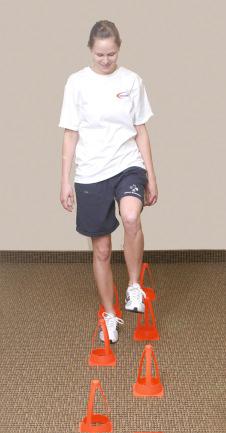
As time progresses from the injury or surgery, another gait activity may be used that requires the patient to wear a heavy elastic band around the distal thighs (~2 finger widths above the patella) and then produce a marching pattern to provide a resisted-gait cycle. With a central line on the floor, the patient, while marching, must maintain right foot-strike on the right side of the line and left foot-strike on the left side of the line ( Fig. 29-10 ). This movement into swing ensures that adequate hip flexion and hip abduction musculature is used during the gait cycle. In addition, the stance limb requires adequate push off of the gastrocnemius as well as a voluntary quadriceps contraction to prevent a hyperextension episode. This resisted-gait activity can be completed in forward, backward, and lateral directions. Each direction allows the clinician to emphasize what muscle groups are used to allow for adequate voluntary muscle control. Again, these activities require voluntary thought processes to focus on recruiting the quadriceps to avoid the hyperextension mechanism from occurring.
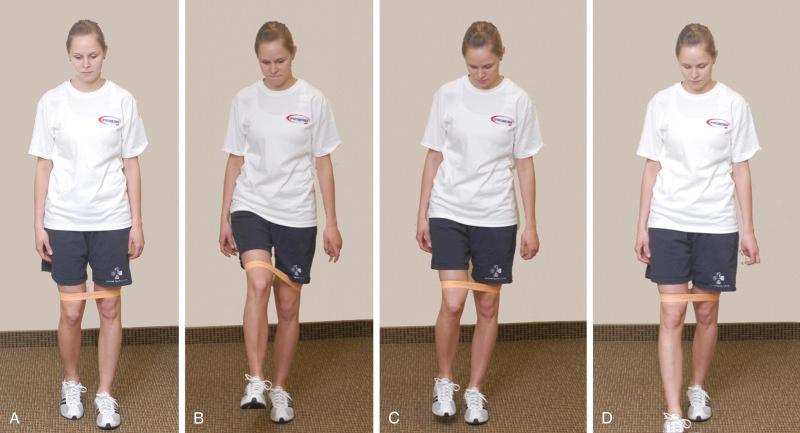
In our experience, after approximately two to four sessions, the patient will understand the abnormal mechanics and recognize when the hyperextension patterns occur. As already discussed, mental reminders, such as “knee bent, toe push-off,” are helpful in this stage. After approximately 4 to 6 weeks of training, the patient should convert to a more normal gait pattern. However, it may require 2 to 3 months to complete the training process to the point where a normal gait pattern becomes routine on a subconscious level and the patient does not resume the hyperextension gait pattern when walking quickly.
Become a Clinical Tree membership for Full access and enjoy Unlimited articles
If you are a member. Log in here